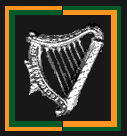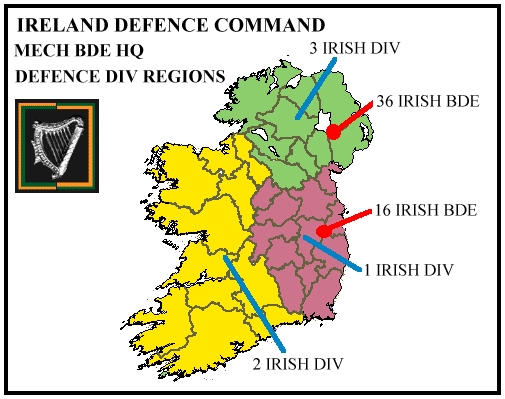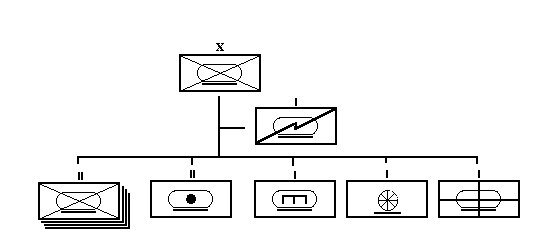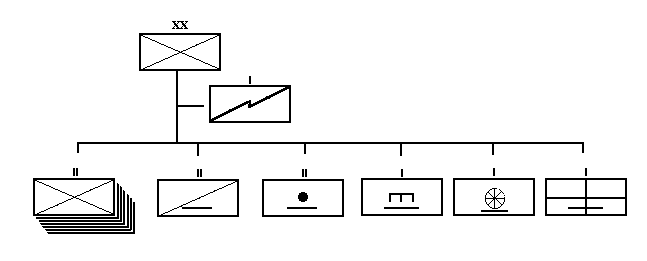Irish Army: 2300AD Ireland Defence Command
Acknowledgements Thanks to Bryn Monnery and Sean Nolan. Introduction The Ireland Defence Command is the element of the joint Anglo-Irish defence establishment tasked with the defence of the island of Ireland. In times of war the IDC would come directly under the command of the Joint British Isles Defence Command (JBID). JBID is a unified command system integrating the air, sea and land forces of Britain and Ireland.
The old Irish Defence Force disintegrated under the pressures of the Twilight War. The stresses of the stalemated, vicious conflict with the north combined with the collapse of the Republic's economy and central government due to the nuclear strikes in the south and fallout from the continent. Soon Ulster and northern Leinster were battlegrounds, Munster was a radiated dead zone and Connaught was acting on its own. Only the area around Dublin was still under the control of the Irish Provisional Government. The long climb back from the chaos took no little time in spite of outside intervention from both Britain and France. What resulted was the reunification of Ireland as a loose federation of the four provinces under the aegis of the British Commonwealth. This allowed Unionists a continued link with Britain whilst Republicans had a unified Irish state. Highly autonomous provinces meant also that neither community could dominate the other. The links across the Irish Sea also allowed both countries to help each others recovery. Slowly the hatred stoked by the near genocidal battles of the Twilight and Ireland's earlier history began to fade, but would never quite be forgotten. Post-Twilight Ireland was dominated by regional forces, many of which were only under tentative control by any leader. The more disciplined forces of Ulster and the Pale were re-organised, retrained and re-equipped, and alongside British and some French troops began to disband the irregular bands and bring order back to Ireland. Later other units were organised in Leinster, Connaught and Munster. Ireland was exhausted and desperate for peace but some warlords were determined to cling onto power and it wasn't until the early-2020's when the last major strongmen had been dealt with. Ireland's defence was now to gain the basic structure it retains today, with regular units from both Ireland and Britain serving as a central reserve. Regionally recruited volunteers would form defence units in case of major threats to the security of the island. Anglo-Irish links were maintained with Irish units also serving in British formations on Earth and later in the colonies. Irish soldiers also conduct much of their advanced training in British establishments. This relationship is close but not exclusive, IDC units also cross-train with the French and Americans on a frequent basis. Indeed Irish battalions (2 CR and 3 ICR respectively) served under French command in Central Asian and German Reunification Wars. It should be noted however that the majority of Irish units serve in British formations. This does not include Irish units on the British Establishment (such as the Irish Guards) or individual Irish soldiers serving in British units.
The IDC today is composed of a number of mostly regular brigade sized formations as well as three volunteer divisions. The regular units include reconnaissance, fire, air and two manoeuvre groups and can include formations drawn from both Irish and British establishments. The volunteer divisions are organised in a manner similar to French infantry divisions and have had that structure for sometime unlike their British UKDF counterparts. Irish volunteer units either have 'Volunteer' in the title or 'V' for Ulster TA or 'FCA' (Fórsa Cosanta Áitiúil) for reserve units from the other Provinces and Dublin. The IDC is a fixed command headquartered in Dublin, but retains the capability to become a mobile Corps command if required. The CRG is a formation of brigade size tasked to provide surveillance and recce support for the whole IDC. It includes regular medium recce and close recce units as well as a volunteer special forces squadron and special duties artillery OP regiment.
The CFG is a fairly small formation that interfaces closely with both the CRG and the CS artillery formations attached at brigade and division level. It is normally manned with one heavy MLR regiment and one volunteer air defence regiment, however it can swiftly bring the other artillery formations under control to deliver required volumes of fire.
The CAG is the Irish contribution to both the air defence, strike capability and the tactical mobility of the IDC. The 1st Regiment is equipped with one squadron of Hunter multi-role fighter aircraft and two squadrons of Wasp fighter drones. The 2nd Regiment has two squadrons of tactical lift tilt-rotors and one squadron of surveillance drones. The 3rd Regiment is responsible for VIP transport and liaison tasks using a variety of civilian aircraft.
16 Irish Bde is the regular mechanised brigade based in the south of Ireland, and is headquartered at the Curragh. It is numbered for the 16th (Irish) Division of the WW1. The brigade currently has two British battalions in its strength as two Irish battalions have transferred across to the British establishment for service on the French Arm. 1 LI in particular has just returned from fighting with the Kafers and is not yet back to full combat strength.
36 Irish Bde is the regular mechanised brigade based in the North of Ireland, and is headquartered at Theipval Barracks, Lisburn and stationed across Ulster. The unit is numbered after the 36th (Ulster) Division that fought in the 1st World War. It is normal for two of this formations units to be provided by British units.
1 Irish Div is the defence division drawn from the east coast of Ireland from Dublin and Leinster.
2 Irish Div is drawn from Munster and Connaught.
3 Irish Div is drawn from the province of Ulster.
The IDC has two Mech Brigades (16 and 36) which provide the backbone of the immediate defence capacity for the island. However the potential for an invasion is relatively unlikely so these brigades have plenty of time to conduct individual and sub-unit training. These formations are generally seen as something of a backwater assignment for the regular troops. The exception to this rule is the occasional use of troops in support of the police in flash points such as the worst suburbs of Belfast, Derry and Dublin or in sweeps against extremist cells. However the Kafer threat has recently resulted in an increased priority for formation training. Each brigade is organised with four mechanised infantry battalions, one mechanised artillery regiment and one engineering squadron. Service support is represented by a brigade logistics company and an armoured field ambulance. The brigade's main platform is the light but versatile Dragoon ACV which comes in a variety of models. Each infantry battalion has four fighting companies, three infantry and one tank destroyer in addition to support and HQ companies. The artillery also uses a 165mm Light Gun on a Dragoon platform. Below: Brigade organisation diagram
The IDC has three Defence Divisions composed of volunteer soldiers. The divisions on mobilisation provide the IDC with extra manpower and capacity to defend lines of communications as well as undertake infantry intensive operations such as in urban areas or in forests. These divisions are transported in soft skinned vehicles and so have limited tactical mobility. Each division has a reconnaissance regiment, seven infantry battalions, an artillery regiment in addition to combat support and service support units. The infantry battalions have between three and five rifle companies as well as support weapons and command cadres. Below: Division organisation diagram
Copyright 2009, D Hebditch
|





